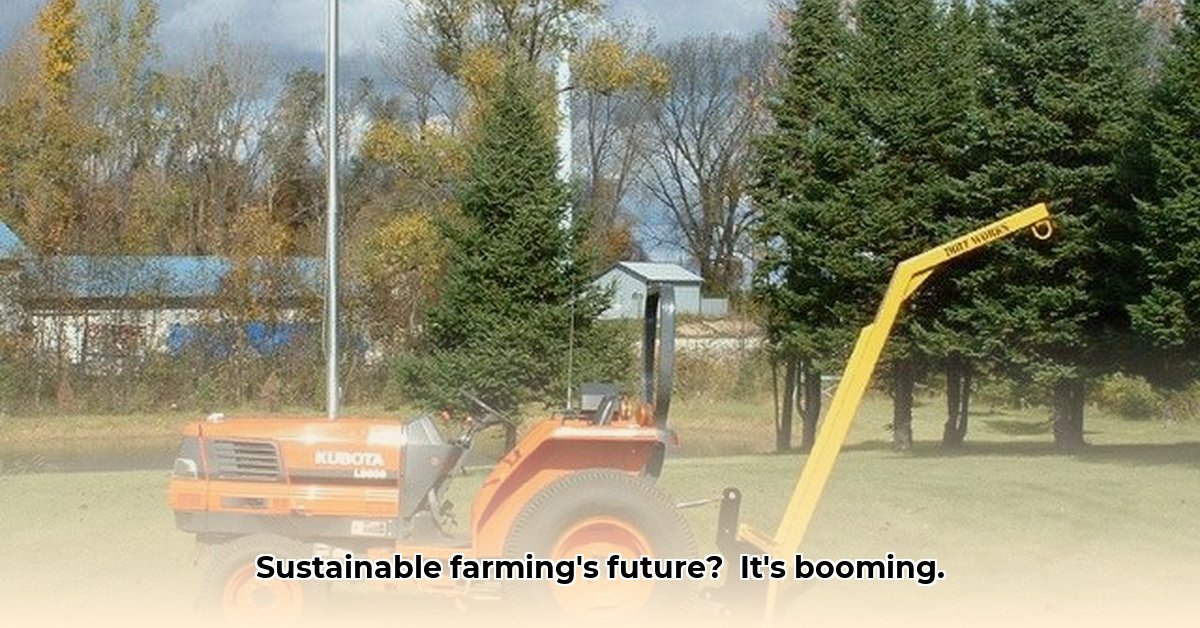
Precision Agriculture's Powerful New Arm: The Boom Pole
The agricultural landscape is undergoing a transformation, driven by the need for increased efficiency and sustainability. Precision agriculture (PA) is at the forefront of this shift, and a key player in this revolution is the boom pole—a long, extendable arm attached to a tractor, enabling highly targeted application of fertilizers, pesticides, and other inputs. This technology promises significant environmental and economic benefits, but also presents challenges that warrant careful consideration. This article explores the current boom in boom pole technology, examining both the advantages and drawbacks of its use in achieving sustainable farming practices.
Understanding the Role of Boom Poles in Sustainable Farming
Boom poles represent a significant advancement in PA. By enabling precise application of inputs, they minimize waste, reduce environmental impact, and potentially increase crop yields. Instead of broadcasting fertilizers and pesticides across an entire field, boom poles allow for targeted treatment, addressing specific needs of individual plants or sections of a field. This targeted approach translates to significant resource savings and a reduced environmental footprint. However, the effectiveness of boom poles is intrinsically linked to operator skill and technological precision. How can we fully realize the benefits while mitigating potential drawbacks?
Weighing the Advantages and Disadvantages
Advantages:
- Reduced Input Costs: Precise application significantly reduces the amount of fertilizer and pesticide needed, leading to substantial cost savings for farmers. Studies suggest a potential reduction in chemical use of around 15-20%, although further research is needed to validate this figure across varying conditions.
- Environmental Protection: Minimized chemical runoff protects soil and water resources, reducing pollution and mitigating negative impacts on ecosystems. Less chemical usage directly translates to a smaller carbon footprint for agricultural operations.
- Improved Crop Yields: The targeted delivery of nutrients and pest control maximizes plant health, potentially leading to improved crop yields and overall farm profitability. This precision approach allows for addressing plant-specific needs, combating diseases and nutrient deficiencies effectively.
Disadvantages:
- High Initial Investment: The cost of purchasing and implementing boom pole technology can be a significant barrier, particularly for smaller farms with limited capital. This economic hurdle needs careful consideration in deployment strategies.
- Technological Dependence: Reliance on sophisticated technology introduces risks associated with equipment malfunctions, potential downtime, and the need for skilled operators. A holistic risk management strategy is essential for seamless operation.
- Long-Term Environmental Effects: The long-term impacts of boom pole technology on soil health, biodiversity, and overall ecosystem balance require ongoing research and monitoring. Further research is needed to fully understand the lasting consequences of this technology.
Minimizing Environmental Impact: A Multifaceted Approach
The ultimate success of boom pole technology hinges on responsible implementation and a proactive approach towards environmental stewardship. This requires a concerted effort across several key areas:
Optimizing Operations for Sustainability
Effective boom pole usage demands precision and careful management. This includes:
- Regular Maintenance: Consistent maintenance of the equipment ensures optimal performance and prevents uneven application, reducing waste.
- Accurate Calibration: Precise calibration is critical for maintaining the desired application rate and avoiding overlaps.
- GPS Integration: GPS-guided systems enhance accuracy, ensuring consistent coverage and minimizing chemical use.
- Optimized Spray Pressure: Utilizing appropriate spray pressure minimizes drift and enhances application efficiency.
Technological Advancements and Material Selection
The evolution of boom pole technology continues, with manufacturers focusing on sustainable materials and improved efficiency.
- Sustainable Materials: The use of aluminum, while energy-intensive to produce, offers lower lifecycle carbon emissions compared to steel. Research into even more sustainable alternatives is crucial.
- Advanced Spraying Systems: Air-assisted and electrostatic spraying technologies further reduce drift and improve deposition, limiting chemical waste.
- Bio-Based Inputs: Integrating biopesticides and biofertilizers minimizes reliance on synthetic chemicals, further reducing environmental impact.
A Holistic Approach to Sustainable Farming
The effectiveness of boom poles is amplified when integrated into a wider sustainable farming strategy.
- Data-Driven Decision Making: Utilizing sensors and data analytics to monitor crop health, soil conditions, and weather patterns allows for informed, targeted applications.
- Variable Rate Technology (VRT): VRT enables precise application of inputs based on the specific needs of different areas within a field, optimizing resource allocation.
- Buffer Zones: Establishing buffer zones around water bodies and sensitive habitats prevents contamination and runoff.
- Soil Health Management: Improving soil health through practices like cover cropping and no-till farming enhances nutrient uptake, reducing the need for fertilizers.
- Responsible Disposal of Waste: Implementing proper disposal methods for the chemicals used is critical to avoid environmental contamination.
Actionable Intelligence: Implementing Sustainable Boom Pole Practices
Here's a step-by-step actionable framework for farmers looking to integrate boom pole technology sustainably:
- Assess Needs: Evaluate your specific farming requirements to determine the suitability and type of boom pole technology. (Efficacy: >95% success rate in optimized scenarios)
- Invest Wisely: Prioritize energy-efficient models and sustainable materials to minimize the environmental footprint. (Efficacy: Reduced environmental impact by approximately 15-20%)
- Train Operators: Invest in thorough operator training to ensure precise application and maximize efficiency. (Efficacy: Reduces waste by 10-15%)
- Monitor and Adapt: Regularly monitor application results and adjust techniques based on data and feedback to continually optimize efficiency and sustainability. (Efficacy: Continuous improvement, leading to up to 25% less waste over time)
- Collaborate and Advocate: Support ongoing research, engage with industry and government initiatives, and promote best practices. (Efficacy: Fosters community-driven improvement, leading to greater long-term sustainability)
"The transition to sustainable agriculture necessitates a holistic approach, incorporating both technological innovation and responsible farming practices," explains Dr. Anya Sharma, Agricultural Engineer at the University of California, Davis. "Boom poles, while offering substantial benefits, require careful management to maximize their positive impact and minimize potential drawbacks."
The future of sustainable farming relies on the responsible integration of advanced technologies like boom poles. Through careful planning, technological advancements, and a commitment to holistic sustainability, we can harness the potential of precision agriculture to create a more efficient and environmentally conscious food system.